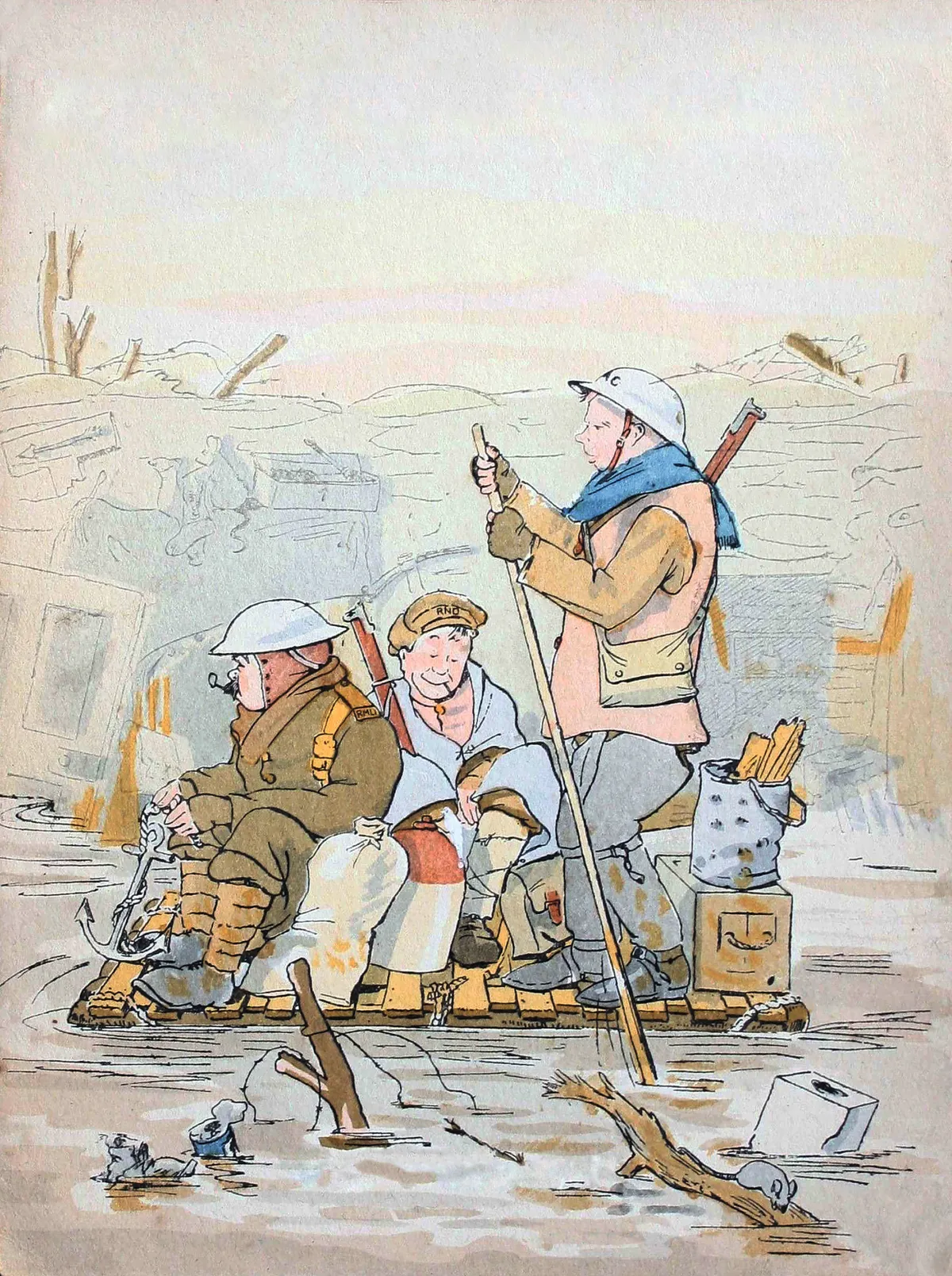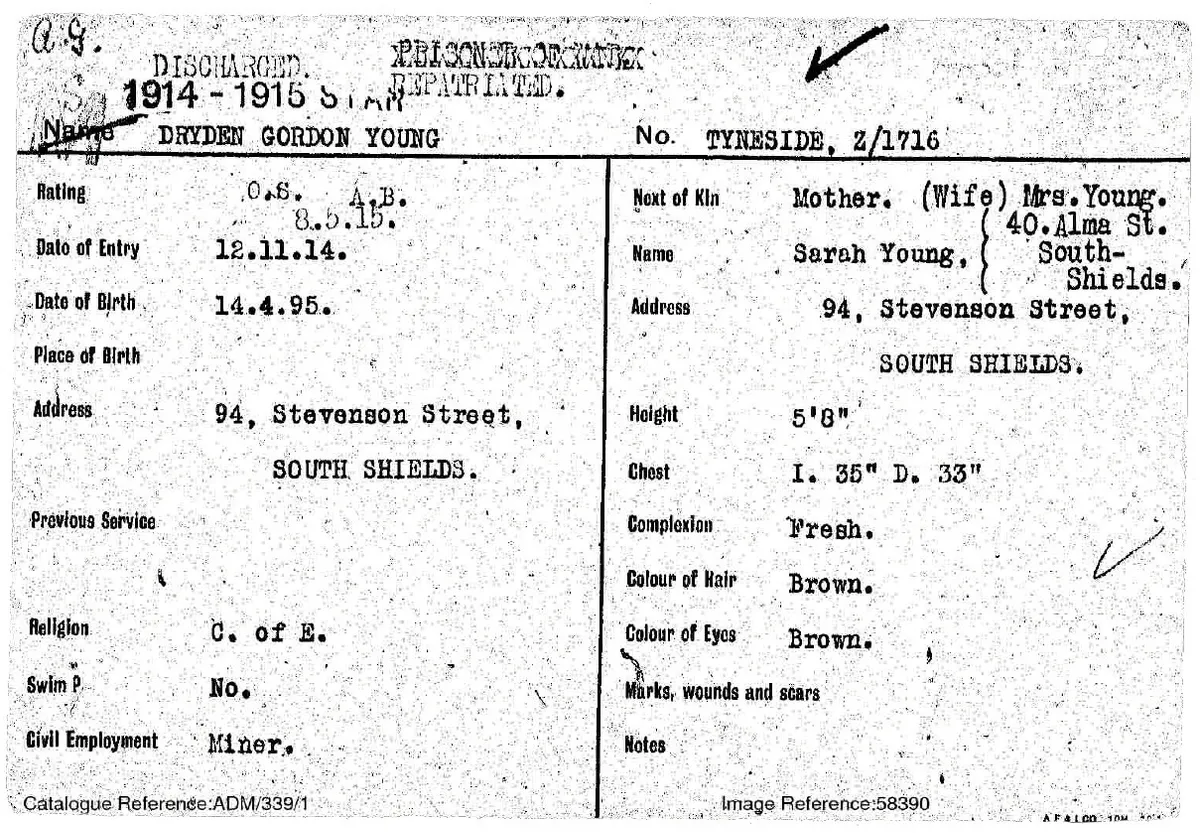Shortly after the outbreak of the First World War it was realised that the Royal Navy had been too effective at recruitment. There was an excess of recruits, and not enough jobs for them. They were initially made naval reservists, but soon reorganised into the nucleus of an Army-style division of light infantry for deployment on land. This was named the Royal Naval Division (RND).
Men initially joined the RND from two principal services. The first was the burgeoning ranks of new naval reservists such as the Royal Naval Reserve (RNR) and the Royal Naval Volunteer Reserve (RNVR). RNR personnel had prior seagoing experience as merchant seamen or fishermen, whereas RNVR men did not. Comedian Chris Ramsey’s great grandfather, Dryden Gordon Young, joined via the RNVR route. The second early source of RND servicemen was the Royal Marines, initially as a separate brigade. As an example, Thomas Cobb, an experienced Marines sergeant, was transferred to the RND in 1914.
At the outset, the RND was partitioned into eight battalions named after admirals: Anson, Benbow, Collingwood, Drake, Hawke, Hood, Howe and Nelson. Despite being an infantry division, the RND was commanded by the Admiralty not the Army.
The RND fought at Ostend and Antwerp in Belgium early in the war, as well as the Dardanelles campaign in 1915. Now known more familiarly as ‘Gallipoli’, this was a British action against one of Germany’s allies: the Ottoman Empire (Turkey). It was an attempt to defeat Turkey, weaken the enemy supply chain, and ensure control of the Suez Canal. However, it ended in failure and cost the lives of more than 130,000 men from Britain, the Empire and the Allies – and nearly 400,000 were wounded.

For example, Dryden Young was bayoneted in the face while attempting to capture Turkish trenches, and had to be evacuated to hospital in Malta. As first lord of the Admiralty Winston Churchill had political responsibility for this military disaster, and was forced to resign. The damage to the RND was extreme, and Benbow and Collingwood were disbanded due to their heavy losses.
Management of the RND was now transferred to the Army, and extra men joined from army battalions. For example, Harold Percy Chilver was an officer in the Royal Field Artillery (RFA) who became part of the RND, which at this point was renamed the 63rd (Royal Naval) Division.
This revised division fought on the Western Front from 1916 onwards, including battles such as Passchendaele, Arras, the Somme and Welsh Ridge. The RND kept many of its naval traditions while serving in the trenches – insisting on their own versions of the army uniform, employing ships’ bells to tell the time, growing beards, using nautical slang, and perhaps most offensive to their army colleagues they reserved the right to sit down rather than stand when toasting the King! These quirks, and their more casual approach to discipline, earned the RND a certain reputation for eccentricity – or in the minds of the army hierarchy, “being difficult”. The Royal Naval Division was abolished after the end of the First World War.

Naval reserves accounted for the majority of servicemen, but it’s important to be aware of the three different sources of RND recruitment (the Royal Navy, the Marines or the Army) because this affects where you must look to trace an ancestor’s service.
The single most important source for RND personnel is the service record cards held at The National Archives (TNA) at Kew in series ADM 339. These records mainly cover naval reservists in the RND. Each set has a top card that provides biographical details of the serviceman – date of birth, address, former job, physical description – as well as details of next of kin. The ensuing cards document each man’s military movements and activities. These details were typed up in the order in which they were received, not the order in which they happened, so you will often need to unpick each man’s timeline carefully. The date on which an event happened is usually given at the end of each event. Events recorded include orders, sickness and injury, being taken prisoner, and communications with a soldier’s family. For example, Dryden Young was reported missing in action on 30/31 December 1917 at Welsh Ridge and his family were informed. However, his wife received a postcard from him soon afterwards, stating that he had become a prisoner of war (POW) at Limburg Camp in western Germany. She sent this news to the Admiralty, who received it on 30 January 1918.

The RND record cards in ADM 339 don’t include Royal Marines, however. You should consult TNA’s research guides for Royal Marines to find the service records for these officers and men, which should include their RND service. For example, Sergeant Thomas Cobb’s service records in ADM 159 show that he fought as part of the ‘Marine brigade’ of the RND in the Defence of Antwerp in 1914, but was captured by the Germans as a POW.
Similarly, army personnel in the RND have their military service described in their British Army service records, which you can locate via the information in TNA’s guides. Harold Chilver’s First World War career, for example, is in TNA series WO 374, which records him rising to the rank of major and receiving the Military Cross for bravery.
Each RND battalion has a War Diary that documented its activities in considerable detail by date. They describe where troops were stationed and what they were doing including training, fighting, resting and being inspected. The diary recorded the arrival of fresh officers and men, injuries and sickness, the weather, and much else.
You can search for War Diaries for the RND on the Western Front from 1916 onwards by battalion name on TNA's website. You can also download them for free. Note that RND War Diaries during Gallipoli (1914–1916) are available via Ancestry.
Just as with service records, finding documentation of your RND ancestor’s First World War campaign medals depends on the identity of the ‘parent service’ that released them to the RND. The Army kept some RND medal records. Accordingly, the records in series WO 372 can be searched by name and then downloaded via TNA’s website. So, for example, a record of the medals issued to army officer Harold Chilver can be found within this series. However, the medal records for most of the servicemen who joined the RND via the Royal Navy are included in the Admiralty’s records (ADM 171) rather than the Army’s. You can search ADM 171 by name on Ancestry. So, the medals issued to Dryden Young are in this series as well as those for William Gibson and Royal Marines such as Sergeant Thomas Cobb.
